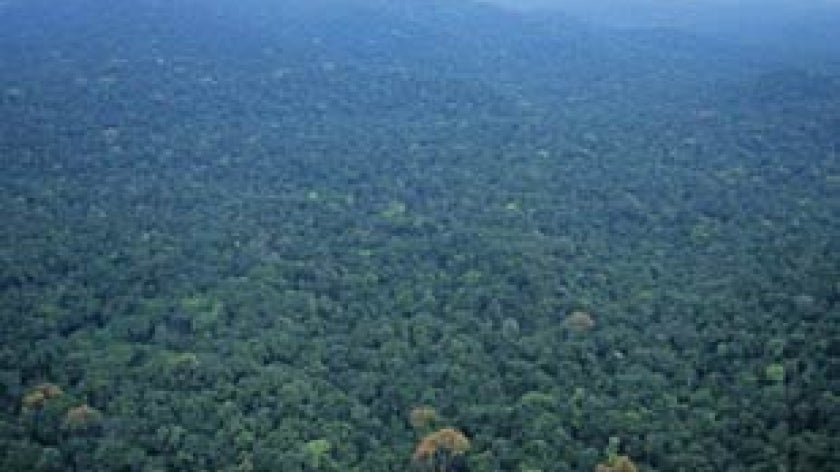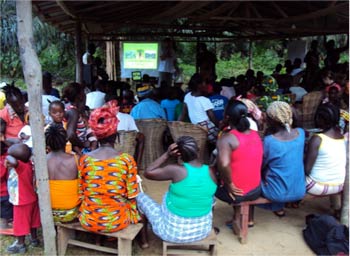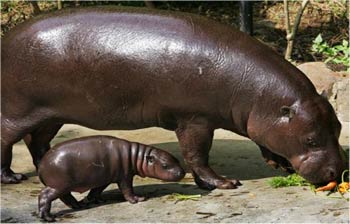

An enormously valuable environmental and economic asset, Liberia’s forests house a range of important biodiversity including, some 240 tree species, 2,000 flowering plants, 125 mammal and 590 bird species, 74 reptiles and amphibians and over 1,000 insect species. Rural communities depend heavily on the forests for fuel wood, building materials, foods and medicinal plants, as well as a wide range of other non-timber forest products. Properly managed, Liberia’s forests have great potential to contribute, in a balanced way, to long-term, sustainable economic growth and employment, supporting the livelihoods of local and rural communities, and ensuring that their important national and global biological heritage is conserved.

To spur the lifting of the sanctions, an ambitious forests sector reform process was launched in 2004, led by the establishment of the Liberia Forests Initiative (LFI). This multi-donor platform, initiated by the Liberian Forestry Development Authority and the Government of the United States, brought together the World Bank and a coalition of donor governments, lending agencies, nongovernmental organizations and civil society participants.
The LFI supported a cross-cutting approach to forests sector reform through promotion of transparent, sustainable, fiscally prudent forest sector management, with a view to improving the livelihood of communities in forested areas. Its objectives included building local capacity for improved forest management, establishing sustainable policies and good practices, tracking revenues, supporting a “Chain of Custody” system to verify legal timber practices and creating a network of protected areas. Forest conservation efforts were promoted using what has come to be known as the “3Cs – commercial, community and conservation – forestry” approach.

The World Bank has supported Liberia’s forests sector reform through a variety of initiatives. GEF funding in particular, has allowed the Bank to provide critical support for three key projects.
One has resulted in the elaboration and adoption of an effective park management process in the Sapo National Park, recognized as the most pristine tract of forest in West Africa and home to the pygmy hippopotamus. Another has laid the foundations for the creation of a protected areas network that will encompass 5 protected areas in the country’s western region, and the third area of intervention seeks to entrench sustainable community livelihoods around Liberia’s protected areas.
The success of Liberia’s overall forest sector reform, supported by its GEF-funded activities, has paved the way for scale-up in the sector.
The “3 Cs” approach has evolved into the “4 Cs” approach with the addition of carbon, as the Government actively seeks to tap into the country’s carbon sequestration potential.
| Project | Project | Project | |
| Establishing the Basis for Biodiversity Conservation on Sapo National Park and in South-East Liberia | Consolidation of Liberia's Protected Area Network | Biodiversity Conservation through Expanding the Protected Area Network in Liberia (EXPAN) | |
| Duration: | 6 years (September 205 - July 2011 | 3 years (July 2088 - April 2011 | 3 years (July 2010 - July 2013 |
| GEF Grant: | 1,000,000 | 860,000 | 950,000 |
| Co-financing: | 1,439,000 | 6,630,000 | 9,168,000 |
| Contact Person: | Oliver Braedt, Sr Natural Resource Management Specialist (obraedt@worldbank.org) | Oliver Braedt, Sr Natural Resource Management Specialist (obraedt@worldbank.org) | Oliver Braedt, Sr Natural Resource Management Specialist (obraedt@worldbank.org) |
| Project website: | Facebook Account | ||
| Project Documents | Project Documents | Project Documents |
As part of GEF's support to the International Year of Forest, every month we are publishing a story about a successful GEF project that is promoting sustainable forest management, and having positive impacts on forests, climate, biodiversity and local livelihoods.